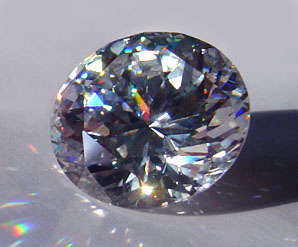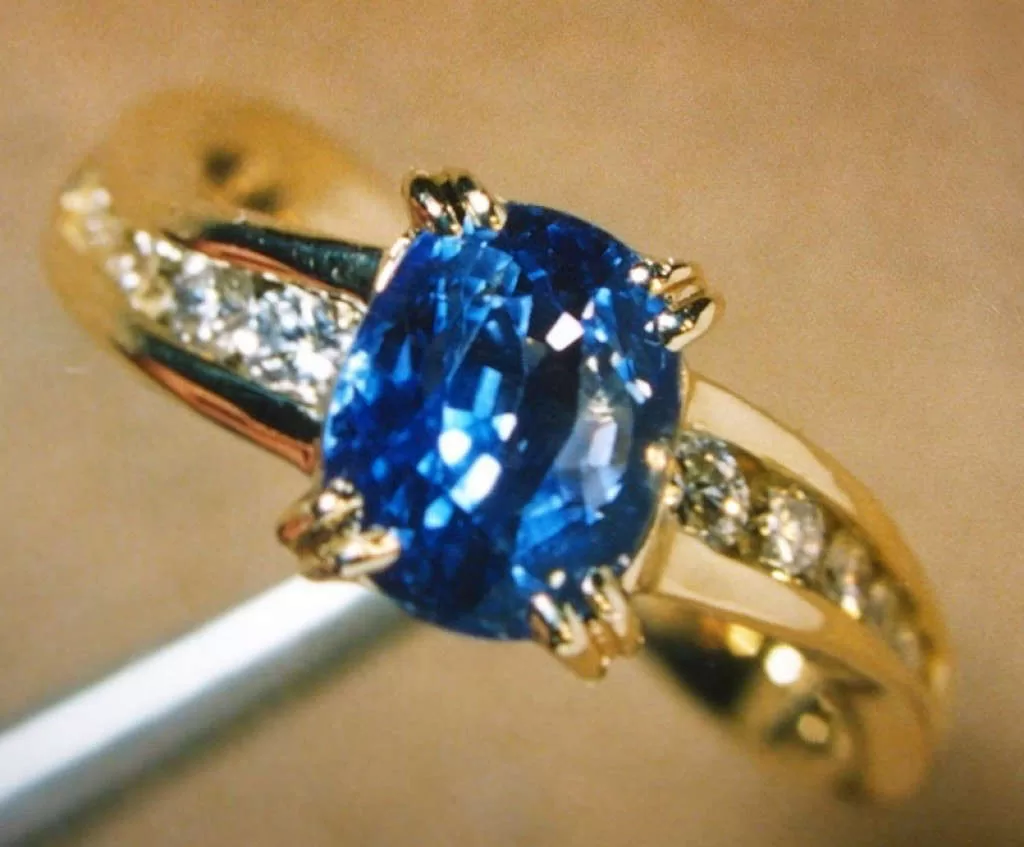Ceylon Sapphire & 18kt gold engagement ring
Source: gemteck1 – CC BY 2.0 – via Wikimedia Commons
Stunning But Impractical Alternatives to Diamond
There are a number of fabulous gemstones that would look stunning in an engagement ring. In fact, a search on the Internet returns dozens of alternative gemstones for engagement rings.
Unfortunately, many gemstones simply cannot hold up to the stress of everyday wear because they are either too brittle or too soft.
Many of these gemstones are sold as alternatives for engagement rings even though they are not an ideal choice for use in engagement rings.
Finding a Good Alternative to Diamond
A number of factors must be considered when looking for an alternative gemstone for an engagement ring. The following are some characteristics that you should look for when choosing a gemstone for use in an engagement ring:
Gemstone Hardness
The Mohs scale created by Friedrich Mohs in 1822 helps indicate the hardness of a gemstone as measured by the relative hardness or scratch resistance of various minerals.
Diamond, the hardest natural substance known scores a 10 on the Mohs scale. Sapphires are a 9 on the Mohs scale. The scale only classifies a gemstone’s hardness in comparison with other gemstones and not its relative hardness in comparison to its position on the Mohs scale.
For example, although a sapphire has a hardness of 9 on the Mohs scale, a diamond is almost 4 times harder than a sapphire.
Quartz, ranking a 7 on the Mohs scale, is the most common mineral on earth and is a large component of common household dust. Any gemstone ranking lower than a 7 will be easily scratched during normal everyday use.
Mohs Scale of Mineral Hardness
| Mohs Hardness | Mineral | Absolute Hardness |
|---|---|---|
| 10 | Diamond | 1500 |
| 9 | Corundum (Ruby, Sapphire) | 400 |
| 8 | Topaz | 200 |
| 7 | Quartz | 100 |
| 6 | Feldspar | 72 |
| 5 | Apatite | 48 |
| 4 | Fluorite | 21 |
| 3 | Calcite | 9 |
| 2 | Gypsum | 3 |
| 1 | Talc | 1 |
Gemstone Toughness
Gemstone hardness is not the only factor to consider when choosing a diamond alternative for an engagement ring.
The hardness of a gemstone only refers to its resistance to being scratched. Some gemstones that are quite hard can be easily broken.
Even a diamond can be damaged if it is improperly set or knocked against something hard.
The gemstone Topaz has a Mohs scale hardness of 8 and yet it will fracture easily if hit with force on a hard surface.
Reasons Why You May Not Want a Diamond Engagement Ring
There are a number of reasons to prefer to use something other than a diamond in your engagement ring.
Diamonds Are Expensive
Not everyone can afford the expense of real diamonds. There are less expensive alternatives to diamonds that have a similar look or why not go with a completely different look?
Don’t Like the Look of Diamonds
Diamonds may be flashy however most natural diamonds sold today lack vibrant color. While diamonds may be the gemstone that most choose for their engagement ring, there is no reason why you have to have a diamond if you don’t like the look.
Diamonds Are Not Tradition
Many think that a diamond engagement ring is a timeless tradition and is simply a must. This is actually not true. Diamonds did not become popular for use in engagement rings until the 1930s. Marketing strategies have continued to give the perception that diamonds are a tradition.
Diamonds Are Not Rare
Compared to other gemstones, diamonds are actually not rare at all. While it is true that high-quality flawless diamonds are rare, new technologies such as laser drilling have made it possible for poor quality diamonds to look closer to flawless.
Are Not a Good Investment
Diamonds are not that good an investment. Try to sell your diamond engagement ring and you will be lucky to get what you paid for it. Many pawnshops often don’t even consider the value of the diamond and just value the ring by the melt value of the gold or other metal that the ring is made of.
Diamonds are Used to Support Illegal Activities
Blood or Conflict Diamonds are used to finance terrorist activities and are used by rebel groups to fuel conflicts and civil wars.
Diamonds Are Not Always Clear
If it’s the color you don’t like about diamonds there are many colored diamonds available including black, grey, purple, pink, red, orange, brown, yellow, olive, green, and blue.
The colors in diamonds are caused by impurities in the diamond or are created artificially by treating the diamond.

Source: Waerloeg – CC BY 3.0 – via Wikipedia
Lab-Created Gemstones are “Genuine” Gemstones
Note: Lab-created gemstones have the same properties and chemical composition as their natural counterparts and are often called “real” or “genuine” however they are not “natural” and do not have the value of natural gemstones.
This is especially true of high-quality natural untreated gemstones which are very rare in most cases and usually command a much higher price.
When shopping for gemstone jewelry, instead of asking, for example, “Is this ruby real?“, you may wish to consider asking “Is this ruby natural?“.
The Many Colors of Sapphires
Sapphires are a variety of corundum. Although blue is the most well-known color, sapphires can come in a variety of colors including colorless, black, pink, purple, brown, green, and orange.
A highly prized color of sapphire is known as Padparadscha which is a light salmon-colored gemstone. True natural Padparadscha Sapphires come only from Sri Lanka.
Color-Change Sapphires colors when viewed in incandescent or fluorescent light.
Star Sapphires exhibit a property called asterism which is derived from the Latin word for “star”. The star effect in Star Sapphires is caused by inclusions in the gemstone.
Natural sapphire is often heat-treated to improve color and clarity.
Lab-created sapphire is often used in mass-produced jewelry. While lab-created sapphire is not natural it has the same chemical properties as a natural sapphire.
With a Mohs hardness of 9 sapphires are very hard and also have the advantage of being quite tough. This makes them an ideal gemstone to use in your engagement ring.
Rubies Beautiful Alternative for Engagement Rings
Rubies are a variety of corundum and have the same properties as sapphire. In fact, the only real difference between ruby and sapphire is the color and possibly the location where it was discovered.
In order to be called a ruby, corundum must meet a specific color range of red. The most popular color ruby is known as “Pigeon Blood Red” which is a deep red with a slightly bluish hue.
Most natural rubies on the market today are heat-treated to improve their color and clarity.
As with sapphire, most rubies found in mass-produced jewelry such as those found in your local jewelry store are lab-created.
Chrysoberyl and Color Changing Alexandrite
Not to be confused with Beryl, Chrysoberyl has a Mohs hardness of 8.5 and excellent toughness. Chrysoberyl is most commonly a yellowish-green color.
A highly prized form of Chrysoberyl is called Alexandrite. Alexandrite is a color-change variety of Chrysoberyl and is the birthstone for those born in June.
Due to the high cost of Alexandrite, most Alexandrite on the market today is lab-created.

Source: Gregory Phillips – CC BY 3.0 – via Wikimedia Commons
Cubic Zirconia, an Inexpensive Alternative to Diamond
Cubic Zirconia commercial production began in 1976. It has a Mohs hardness of 8-8.5 however it has a relatively low fracture toughness and strength.
Cubic Zirconias or CZ’s for short can come in many colors although it is most often sold as colorless. The most common colors are pink, pink rose, lavender, amethyst, dark amethyst, violet, canary yellow, yellow, champagne, orange, red, garnet, Peridot, and olive Peridot.
Emeralds, The Fabulously Green Alternative to Diamond
Although emerald has a Mohs hardness of 7.5 to 8, natural emerald is generally not suitable for use in an engagement ring due to the natural fractures and inclusions that are usually present. Only high-quality natural emeralds should be used in any type of ring and it should be protected from extreme temperatures or hard impacts.
Due to the high cost and low toughness of emeralds, most emeralds that are used in the jewelry industry today are lab-created.
Lab-created emeralds are much less likely to fracture due to imperfections making them a better choice for use in engagement rings.
The Diamond Alternative Moissanite
Moissanite was discovered in 1893 by Dr. Henri Moissan when analyzing remnants of a meteor in Diablo Canyon.
Only microscopic crystals of Moissanite have ever been discovered in nature.
Marketed exclusively by Carles & Colvard, lab-created Moissanite was introduced to the public in 1998.
Moissanite has a hardness of 9.25 and excellent toughness.
Although Moissanite is not quite colorless, it has exceptional fire exceeding that of a diamond. Tints of green and yellow are also available.
Moissanite has the additional quality of being earth-friendly because it is not mined but is a lab-created jewel.https://youtu.be/kuxYtWys-HcWhat is Moissanite?
Exploring the Alternatives
As you can see there are some wonderful alternatives to diamonds when it comes to gemstones used in engagement rings.
If you plan to purchase an engagement ring for someone you love in the near future, don’t forget to discuss the possibilities of alternative gemstones with your future spouse. She (or he) may be glad you did!

